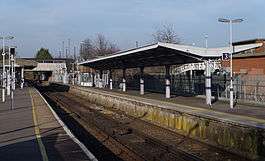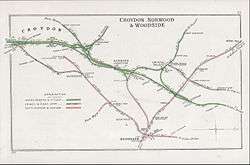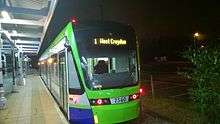Elmers End station
| Elmers End | |
|---|---|
 | |
 Elmers End Location of Elmers End in Greater London | |
| Location | Elmers End |
| Local authority | Bromley |
| Managed by | Southeastern |
| Station code | ELE |
| DfT category | D |
| Number of platforms | 3 (2 for National Rail; 1 for Tramlink) |
| Accessible | Yes [1] |
| Fare zone | 4 |
| Tramlink annual boardings and alightings | |
| 2009–10 | 0.451 million[2] |
| 2010–11 | 0.501 million[3] |
| National Rail annual entry and exit | |
| 2010–11 |
|
| 2011–12 |
|
| 2012–13 |
|
| 2013–14 |
|
| 2014–15 |
|
| Key dates | |
| 1 April 1864 | Opened |
| 29 May 1882 | Hayes branch opens |
| 13 May 1983 | WSCR closes |
| 31 May 1997 | Addiscombe Line closes |
| 29 May 2000 | Tramlink services began |
| Other information | |
| Lists of stations | |
| External links | |
| WGS84 | 51°23′52″N 0°03′00″W / 51.3978°N 0.0499°WCoordinates: 51°23′52″N 0°03′00″W / 51.3978°N 0.0499°W |
|
| |

Elmers End is a railway station and tram terminus in Elmers End, south London, England. It is in the London Borough of Bromley, and Travelcard Zone 4 17 km (11 mi) south of London Charing Cross.
The railway through Elmers End was opened by the South Eastern Railway on 1 April 1864 as an extension of the Mid-Kent Line from New Beckenham to Addiscombe; there was a branch, opened on 29 May 1882 to Hayes at this station.[5] The portion of the line to Addiscombe, which was originally named Croydon (Addiscombe Road), was closed in 1997 when Tramlink took over much of the trackbed from Elmers End.
The Hayes line service on the suburban commuter railway line between Hayes and London Charing Cross through Elmers End is still in use. The station is on Elmers End Road (A214), at the south-east corner of South Norwood Country Park.
One former railway platform is now the terminus for Tramlink routes 1 and 4 to central Croydon.
History
Early years (1857-1922)
The Mid Kent line was built by the Mid-Kent and North Kent Junction Railway (MK&NKJR) and was opened on 1 January 1857 as far as Beckenham Junction. From opening the line was worked by the South Eastern Railway (SER). Seven years later the MK&NKJR built an extension from a new junction station at New Beckenham to Croydon (Addiscombe Road) with an intermediate station at Elmers End, which again was operated by the SER from opening. The station was occupied in what was then a rural area with scattered farm houses and hamlets. The station building was located on the down side whilst a goods yard was provided on the up side.
By 1914 Elmers End had almost become part of Beckenham on the east side of the railway. On the opposite side a sewage works, the Croydon Council refuse destructor, Beckenham Council's refuse destructor and electric power station as well as two brick works and Crystal Palace District Cemetery were all located. Sidings served the Croydon and Beckenham Council sites.[6]
The station was rebuilt in 1881/2 in anticipation of the opening of the Hayes branch. Bay platforms were provided on the up and down side and a new 43 lever signal box was provided immediately south of the station. New coal sidings, in anticipation of further suburban growth, were also provided on the up side.[7]
The Elmers End – Hayes section was built by the West Wickham & Hayes Railway, and left the existing line just south of the station on a tight 13 chain curve. It was sold to the South Eastern Railway in 1881 and opened on 29 May 1882. Initially 13 services each way were operated between Elmers End and Hayes with central London passengers having to change trains.[lower-alpha 1]
In 1898 the South Eastern Railway and its bitter rivals the London Chatham and Dover Railway agreed to work as one railway company under the name of the South Eastern and Chatham Railway and Elmers End became an SECR station.
Southern Railway (1923-1947)
Following the Railways Act 1921 (also known as the Grouping Act), Elmers End became a Southern Railway station on 1 January 1923.
The Mid-Kent line was electrified with the (750 V DC third rail) system and electric services commenced on 28 February 1926. Early electric services were worked by early Southern Railway 3-car Electric Multiple Unit trains often built from old SECR carriages. In connection with the electrification the track bed between Elmers End and Clock House area was raised in an effort to reduce flooding. Electrification led to further house building between Clock House and Elmers End stations.[8]
During World War 2 the station was hit three times by bombs during 1941. Some track alterations took place in 1947 which included the link between the Up Bay and Hayes line being removed, platform lengthening and direct access from the Hayes branch to the down bay.[9]
British Railways (1948-1994)
After World War II and following nationalisation on 1 January 1948, the station fell under the auspices of British Railways Southern Region. Three-aspect colour light signals were installed at the station in 1956.
The goods yard was closed on 6 May 1963.
The station building was destroyed by fire on 16 December 1973
On 28 May 1975 all signalling came under the control of the London Bridge Signalling Centre and the 1882 signal box was closed. The down bay was taken out of passenger use and became an engineer’s siding. Upon sectorisation in 1982, three passenger sectors were created: InterCity, operating principal express services; and London & South East (renamed Network SouthEast in 1986) who operated commuter services in the London area.[10]
The privatisation era (1994-Present Day)
Following privatisation of British Rail on 1 April 1994 the infrastructure at Elmers End station became the responsibility of Railtrack whilst a business unit operated the train services. On 13 October 1996 operation of the passenger services passed to Connex South Eastern who were originally due to run the franchise until 2011.
In 1997 the line to Addiscombe closed – up to this point it was generally worked by a 2-car EMU connecting to and from Hayes services. It re-opened in 2000 as part of the Croydon Tramlink network.
Following a number of accidents and financial issues Railtrack plc was sold to Network Rail on 3 October 2002 who became responsible for the infrastructure.[11][12]
On 27 June 2003 the Strategic Rail Authority decided to strip Connex of the franchise citing poor financial management and run the franchise itself.[13][14] Connex South Eastern continued to operate the franchise until 8 November 2003 with the services transferring to the Strategic Rail Authority's South Eastern Trains subsidiary the following day.
On 30 November 2005 the Department for Transport awarded Govia the Integrated Kent franchise. The services operated by South Eastern Trains transferred to Southeastern on 1 April 2006.
Services

Monday to Saturday daytimes there is a train every 15 minutes towards Central London either to Cannon Street or Charing Cross and to Hayes in the other direction.
Sundays there is a half-hourly service in each direction (to Cannon Street northbound).[15]
Trams depart from the station every 12 minutes; this service falls to four trams per hour during the early morning and evenings. Each tram travels towards Croydon town centre and West Croydon tram stop, before travelling back to Elmers End.
| Preceding station | |
Following station | ||
|---|---|---|---|---|
| Clock House | Southeastern Hayes Line |
Eden Park | ||
| |
||||
towards Wellesley Road | Route 1 | Terminus | ||
towards Therapia Lane | Route 4 | Terminus | ||
| Disused railways | ||||
| Clock House | Network SouthEast Addiscombe Line |
Woodside | ||
| British Rail Southern Region Woodside and South Croydon Railway |
||||
Connections
London Buses routes 54, 356 and 289 serve the station.
See also
Notes
- ↑ The current Hayes service (2016) which serves the station uses the 1857 line to New Beckenham, the 1864 line to Elmers End and the 1882 line to Hayes.
References
- ↑ "Planning an accessible journey with Southeastern" (PDF). Southeastern. May 2009. Retrieved 2 January 2010.
- ↑ "Tram Stop Usage 2009-10 (FOI)" (XLS). Tramlink annual passenger performance 2009-2010. Transport for London. 18 August 2011. Retrieved 28 November 2012.
- ↑ "Tramlink numbers 2010-2011" (PDF). Tramlink annual passenger performance 2010-2011. Transport for London. 28 March 2012. Retrieved 28 November 2012.
- 1 2 3 4 5 "Station usage estimates". Rail statistics. Office of Rail Regulation. Please note: Some methodology may vary year on year.
- ↑ "The Railways of Beckenham", Andrew Hajducki, 2011
- ↑ Jackson, Alan A (1999). London's Local Railways (2nd ed.). Harrow Weald: Capital Transport Publishing. p. 44.
- ↑ Jackson, Alan A (1999). London's Local Railways (2nd ed.). Harrow Weald: Capital Transport Publishing. p. 56.
- ↑ Jackson, Alan A (1999). London's Local Railways (2nd ed.). Harrow Weald: Capital Transport Publishing. p. 47.
- ↑ Mitchell, Vic; Smith, Keith (September 1993). London Bridge to Addiscombe. Midhurst, UK: Middleton Press. p. 73. ISBN 1 873793 20 0.
- ↑ Thomas, David St John; Whitehouse, Patrick (1990). BR in the Eighties. Newton Abbot: David & Charles. ISBN 0-7153-9854-7.
- ↑ Network Rail closer to Railtrack takeover BBC News, 1 April 2016
- ↑ "Accounting for Producer Needs: The case of Britain's rail infrastructure" (PDF). Centre for Management and Organisational History. p. 18. Retrieved 1 April 2016.
- ↑ "BBC NEWS - UK - England - Train firm loses franchise". BBC News. 27 June 2003. Retrieved 1 April 2016.
- ↑ Basher Bowker pulls the plug on Connex The Telegraph 29 June 2003
- ↑ Table 203 National Rail timetable, May 2016
External links
| Wikimedia Commons has media related to Elmers End station. |
- Train times and station information for Elmers End station from National Rail
